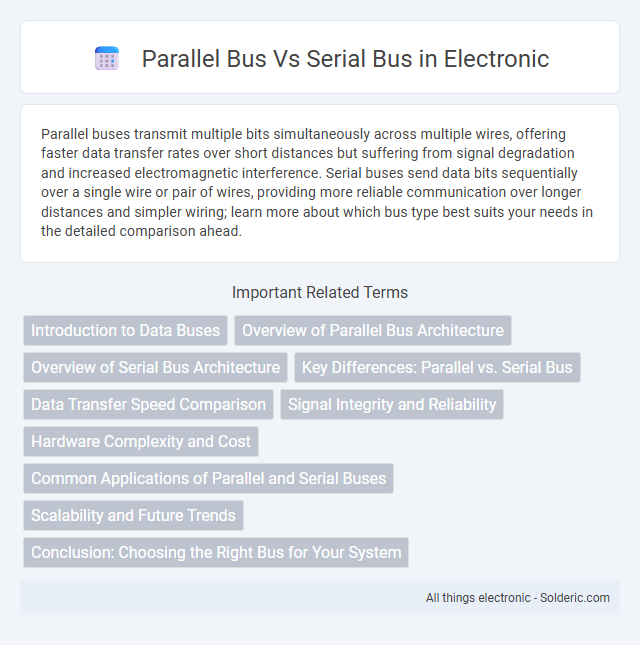Parallel buses transmit multiple bits simultaneously across multiple wires, offering faster data transfer rates over short distances but suffering from signal degradation and increased electromagnetic interference. Serial buses send data bits sequentially over a single wire or pair of wires, providing more reliable communication over longer distances and simpler wiring; learn more about which bus type best suits your needs in the detailed comparison ahead.
Comparison Table
| Feature | Parallel Bus | Serial Bus |
|---|---|---|
| Data Transmission | Multiple bits simultaneously over multiple lines | Bits transmitted sequentially over a single line |
| Speed | High speed over short distances | Efficient at long distances, high-speed with modern protocols |
| Cabling | Thick, multiple wires | Thin, fewer wires |
| Signal Integrity | Prone to crosstalk and signal skew | Better signal integrity, less crosstalk |
| Cost | Higher due to complex cabling | Lower with simpler cables |
| Applications | Internal data buses, early computer architectures | USB, SATA, PCI Express, modern external connections |
Introduction to Data Buses
Data buses are critical components in computer architecture, facilitating communication between the processor, memory, and peripherals. Parallel buses transmit multiple bits simultaneously across multiple channels, enabling faster data transfer but often causing signal timing issues and increased hardware complexity. Serial buses send data bit-by-bit sequentially, offering simpler design, longer cable lengths, and reduced electromagnetic interference, which benefits your system's reliability and scalability.
Overview of Parallel Bus Architecture
Parallel bus architecture transfers multiple bits simultaneously across multiple data lines, enhancing data throughput and reducing transmission time. It consists of separate wires for each bit, along with control and address lines, enabling synchronized data communication between components. Commonly used in older computer systems and interfaces like PCI, parallel buses face limitations due to signal degradation and crosstalk at higher speeds.
Overview of Serial Bus Architecture
Serial bus architecture transmits data one bit at a time over a single channel, reducing the number of physical wires and connectors compared to parallel buses. This streamlined design minimizes electromagnetic interference and crosstalk, enabling higher data transfer rates over longer distances. Common serial bus standards include USB, SATA, and PCIe, which are widely used for efficient, high-speed communication in modern computing devices.
Key Differences: Parallel vs. Serial Bus
Parallel bus transmits multiple bits simultaneously over multiple channels, offering higher data transfer rates but suffering from signal degradation and electromagnetic interference over long distances. Serial bus sends data bit by bit sequentially over a single channel, providing better signal integrity, longer transmission distances, and reduced wiring complexity. Key differences include data transfer speed efficiency in short-distance parallel buses versus scalability and cost-effectiveness in long-distance serial buses.
Data Transfer Speed Comparison
Parallel buses transmit multiple bits simultaneously across multiple channels, achieving higher data transfer rates over short distances, typically up to several gigabits per second. Serial buses send data one bit at a time but leverage higher clock speeds and advanced encoding techniques, enabling sustained high data transfer speeds often exceeding parallel counterparts, especially over longer distances. Technologies like PCI Express (serial) outperform traditional parallel buses such as PCI by delivering faster and more reliable data transfers.
Signal Integrity and Reliability
Parallel buses often face signal integrity challenges due to crosstalk and timing skew among multiple data lines, which can degrade reliability at higher speeds. Serial buses enhance signal integrity by transmitting data bit-by-bit over a single or differential pair of lines, minimizing electromagnetic interference and allowing for cleaner, more reliable communication. High-speed serial interfaces like PCIe and USB leverage advanced signal conditioning techniques, such as equalization and encoding, to maintain data integrity and improve overall system reliability.
Hardware Complexity and Cost
Parallel buses require multiple data lines, increasing hardware complexity and manufacturing costs due to the need for precise timing and signal integrity across all lines. Serial buses use a single data line or fewer lines, reducing the complexity of circuit design and lowering overall cost. The simpler wiring and reduced connector size in serial buses make them more cost-effective for modern electronic devices.
Common Applications of Parallel and Serial Buses
Parallel buses are commonly used in applications requiring high-speed data transfer over short distances, such as connecting internal computer components like CPUs, RAM, and printers. Serial buses excel in peripheral devices and long-distance communication, including USB devices, SATA drives, and network interfaces due to their simplified wiring and reduced signal degradation. Your choice depends on balancing speed and distance requirements for efficient data communication across devices.
Scalability and Future Trends
Parallel buses face significant scalability challenges due to signal timing issues and crosstalk as the number of lines increases, limiting their effectiveness in high-speed or long-distance data transfer. Serial buses, utilizing fewer lines and advanced signaling techniques like differential signaling and high-frequency clocking, offer superior scalability and are increasingly adopted in modern architectures such as PCIe and USB4. Future trends favor serial buses with higher data rates, improved power efficiency, and enhanced lane aggregation capabilities to meet the demands of emerging technologies like AI, 5G, and high-resolution multimedia.
Conclusion: Choosing the Right Bus for Your System
Selecting the right bus for your system depends on factors like data transfer speed, distance, and cost-effectiveness; parallel buses offer higher data rates over short distances but suffer from signal degradation and crosstalk at longer lengths. Serial buses provide reliable communication over greater distances with simpler wiring and lower electromagnetic interference, making them ideal for modern high-speed applications. Evaluating system requirements such as bandwidth, scalability, and physical constraints ensures optimal bus selection for performance and efficiency.
parallel bus vs serial bus Infographic

 solderic.com
solderic.com